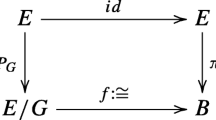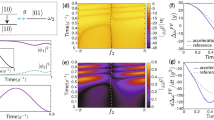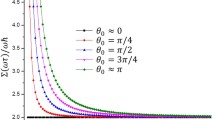Abstract
Geometric quantum computation is the idea that geometric phases can be used to implement quantum gates, i.e., the basic elements of the Boolean network that forms a quantum computer. Although originally thought to be limited to adiabatic evolution, controlled by slowly changing parameters, this form of quantum computation can as well be realized at high speed by using nonadiabatic schemes. Recent advances in quantum gate technology have allowed for experimental demonstrations of different types of geometric gates in adiabatic and nonadiabatic evolution. Here, we address some conceptual issues that arise in the realizations of geometric gates. We examine the appearance of dynamical phases in quantum evolution and point out that not all dynamical phases need to be compensated for in geometric quantum computation. We delineate the relation between Abelian and non-Abelian geometric gates and find an explicit physical example where the two types of gates coincide. We identify differences and similarities between adiabatic and nonadiabatic realizations of quantum computation based on non-Abelian geometric phases.


Similar content being viewed by others
References
Zanardi, P., Rasetti, M.: Holonomic quantum computation. Phys. Lett. A 264, 94–99 (1999)
Pachos, J., Zanardi, P.: Quantum holonomies for quantum computing. Int. J. Mod. Phys. B 15, 1257–1286 (2001)
Lloyd, S.: Computation from geometry. Science 292, 1669 (2001)
Ekert, A., Ericsson, M., Hayden, P., Inamori, H., Jones, J.A., Oi, D.K.L., Vedral, V.: Geometric quantum computation. J. Mod. Opt. 47, 2501–2513 (2000)
Duan, L.-M., Cirac, J.I., Zoller, P.: Geometric manipulation of trapped ions for quantum computation. Science 292, 1695–1697 (2001)
Faoro, L., Siewert, J., Fazio, R.: Non-Abelian holonomies, charge pumping, and quantum computation with Josephson junctions. Phys. Rev. Lett. 90, 028301 (2003)
Solinas, P., Zanardi, P., Zanghì, N., Rossi, F.: Semiconductor-based geometrical quantum gates. Phys. Rev. B 67, 121307 (2003)
Xiang-Bin, W., Keiji, M.: Nonadiabatic conditional geometric phase shift with NMR. Phys. Rev. Lett. 87, 097901 (2001)
Zhu, S.-L., Wang, Z.D.: Implementation of universal quantum gates based on nonadiabatic geometric phases. Phys. Rev. Lett. 89, 097902 (2002)
Zhu, S.-L., Wang, Z.D.: Universal quantum gates based on a pair of orthogonal cyclic states: application to NMR systems. Phys. Rev. A 67, 022319 (2003)
Zhu, S.-L., Wang, Z.D.: Unconventional geometric quantum computation. Phys. Rev. Lett. 91, 187902 (2003)
Sjöqvist, E., Tong, D.M., Andersson, L.M., Hessmo, B., Johansson, M., Singh, K.: Non-adiabatic holonomic quantum computation. New J. Phys. 14, 103035 (2012)
Jones, J.A., Vedral, V., Ekert, A., Castagnoli, G.: Geometric quantum computation using nuclear magnetic resonance. Nature 403, 869–871 (2000)
Du, J., Zou, P., Wang, Z.D.: Experimental implementation of high-fidelity unconventional geometric quantum gates using an NMR interferometer. Phys. Rev. A 74, 020302(R) (2006)
Feng, G., Xu, G., Long, G.: Experimental realization of nonadiabatic holonomic quantum computation. Phys. Rev. Lett. 110, 190501 (2013)
Leibfried, D., DeMarco, B., Meyer, V., Lucas, D., Barrett, M., Britton, J., Itano, W.M., Jelenković, B., Langer, C., Rosenband, T., Wineland, D.J.: Experimental demonstration of a robust, high-fidelity geometric two ion-qubit phase gate. Nature 422, 412–415 (2002)
Toyoda, K., Uchida, K., Noguchi, A., Haze, S., Urabe, S.: Realization of holonomic single-qubit operations. Phys. Rev. A 87, 052307 (2013)
Abdumalikov, A.A., Fink, J.M., Juliusson, K., Pechal, M., Berger, S., Wallraff, A., Filipp, S.: Experimental realization of non-Abelian non-adiabatic geometric gates. Nature 496, 482–485 (2013)
Tian, M., Zafarullah, I., Chang, T., Mohan, R.K., Babbitt, W.R.: Demonstration of geometric operations on the Bloch vectors in an ensemble of rare-earth metal atoms. Phys. Rev. A 79, 022312 (2009)
Arroyo-Camejo, S., Lazariev, A., Hell, S.W., Balasubramanian, G.: Room temperature high-fidelity holonomic single-qubit gate on a solid-state spin. Nat. Commun. 5, 4870 (2014)
Zu, C., Wang, W.-B., He, L., Zhang, W.-G., Dai, C.-Y., Wang, F., Duan, L.-M.: Experimental realization of universal geometric quantum gates with solid-state spins. Nature 512, 72–75 (2014)
Aharonov, Y., Anandan, J.: Phase change during a cyclic quantum evolution. Phys. Rev. Lett. 58, 1593–1596 (1987)
Anandan, J.: Non-adiabatic non-Abelian geometric phase. Phys. Lett. A 133, 171–175 (1988)
Solinas, P., Zanardi, P., Zhanghì, N., Rossi, F.: Nonadiabatic geometrical quantum gates in semiconductor quantum dots. Phys. Rev. A 67, 052309 (2003)
Tian, M., Barber, Z.W., Fischer, J.A., Babbitt, W.R.: Geometric manipulation of the quantum states of two-level atoms. Phys. Rev. A 69, 050301(R) (2004)
Ota, Y., Kondo, Y.: Composite pulses in NMR as nonadiabatic geometric quantum gates. Phys. Rev. A 80, 024302 (2009)
Zhu, S.-L., Zanardi, P.: Geometric quantum gates that are robust against stochastic control errors. Phys. Rev. A 72, 020301(R) (2005)
Azimi Mousolou, V., Canali, C.M., Sjöqvist, E.: Universal non-adiabatic holonomic gates in quantum dots and single-molecule magnets. New J. Phys. 16, 013029 (2014)
Pancharatnam, S.: Generalized theory of interference, and its applications. Part I. coherent pencils. Proc. Indian Acad. Sci. A 44, 247–262 (1956)
Blais, A., Tremblay, A.-M.S.: Effect of noise on geometric logic gates for quantum computation. Phys. Rev. A 67, 012308 (2003)
Unanyan, R.G., Fleischhauer, M.: Geometric phase gate without dynamical phases. Phys. Rev. A 69, 050302(R) (2004)
Berry, M.V.: Transitionless quantum driving. J. Phys. A: Math. Theor. 42, 365303 (2009)
Zhang, J., Kyaw, T.H., Tong, D.M., Sjöqvist, E., Kwek, L.-C.: Fast non-Abelian geometric gates via transitionless quantum driving. Sci. Rep. 5, 18414 (2015)
Song, X.-K., Zhang, H., Ai, Q., Qiu, J., Deng, F.-G.: Shortcuts to adiabatic holonomic quantum computation in decoherence-free subspaces with transitionless quantum driving algorithm. New J. Phys. 18, 023001 (2016)
Messiah, A.: Quantum mechanics. Vol II, p. 744, North-Holland, Amsterdam (1962)
Wilczek, F., Zee, A.: Appearance of gauge structure in simple dynamical systems. Phys. Rev. Lett. 52, 2111–2114 (1984)
Simon, B.: Holonomy, the quantum adiabatic theorem, and Berry’s phase. Phys. Rev. Lett. 51, 2167–2170 (1983)
Florio, G., Facchi, P., Fazio, R., Giovannetti, V., Pascazio, S.: Robust gates for holonomic quantum computation. Phys. Rev. A 73, 022327 (2006)
Fujii, K.: Note on coherent states and adiabatic connections, curvatures. J. Math. Phys. 41, 4406–4412 (2000)
Xu, G.F., Liu, C.L., Zhao, P.Z., Tong, D.M.: Nonadiabatic holonomic gates realized by a single-shot implementation. Phys. Rev. A 92, 052302 (2015)
Sjöqvist, E.: Nonadiabatic holonomic single-qubit gates in off-resonant \(\Lambda \) systems. Phys. Lett. A 380, 65–67 (2016)
Spiegelberg, J., Sjöqvist, E.: Validity of the rotating-wave approximation in nonadiabatic holonomic quantum computation. Phys. Rev. A 88, 054301 (2013)
Ruseckas, J., Juzeliũnas, G., Öhberg, P., Fleischhauer, M.: Non-Abelian gauge potentials for ultracold atoms with degenerate dark states. Phys. Rev. Lett. 95, 010404 (2005)
Acknowledgments
E.S. acknowledges financial support from the Swedish Research Council (VR) through Grant No. D0413201. V.A.M. acknowledges support from the Department of Mathematics at University of Isfahan (Iran). C.M.C. is supported by the Department of Physics and Electrical Engineering at Linnaeus University (Sweden) and by the Swedish Research Council (VR) through Grant No. 621-2014-4785.
Author information
Authors and Affiliations
Corresponding author
Appendix
Appendix
We prove that the space of all dark subspaces of the tripod system is G(3; 2). We do this by demonstrating that for any \(\vert {\psi }\rangle \in \text {Span} \{ \vert {0}\rangle , \vert {1}\rangle , \vert {a}\rangle \}\) there exists \(\varvec{\omega }\) such that
By using the linear independence of the two dark states \(\vert {D_0 (\varvec{\omega })}\rangle , \vert {D_1 (\varvec{\omega })}\rangle \), it follows that Eq. (38) is equivalent to
for \(\vert {\psi }\rangle = \lambda _0 \vert {0}\rangle + \lambda _1 \vert {1}\rangle + \lambda _a \vert {a}\rangle \) with arbitrary complex-valued \(\lambda _0,\lambda _1,\lambda _a\) such that \(|\lambda _0|^2 + |\lambda _1|^2 + |\lambda _a|^2 \ne 0\). By using the explicit form of the two dark states (parameterization taken from Ref. [43]), we find
where \(\omega _0 = \sin \theta \cos \phi e^{iS_1}\), \(\omega _1 = \sin \theta \sin \phi e^{iS_2}\), \(\omega _a = \cos \theta e^{iS_3}\), and \(S_{kl} = S_k - S_l\).
Assume first that \(\lambda _0 \ne 0\) and define \(z_1=\lambda _1/\lambda _0, z_a=\lambda _a/\lambda _0\). We find
This can be solved for all \(z_1,z_a\) since \(\theta ,\phi ,S_{21},S_{31}\) are independent variables. Explicitly, one finds \(\phi = \tan ^{-1} |z_1|\), \(S_{21} = -\arg z_1\), \(\theta = \cot ^{-1} \left[ |z_a|/ \sqrt{1+|z_1|^2}\right] \), and \(S_{31} = -\arg z_a\). Next, we assume that \(\lambda _0 = 0\) but \(\lambda _1 \ne 0\), and define \(\tilde{z}_a = \lambda _a/\lambda _1\). We find
with solution \(\theta = \cot ^{-1} | \tilde{z}_a|\) and \(S_{32} = -\arg \tilde{z}_a\). Finally, if \(\lambda _0 = \lambda _1=0\), then \(\theta = 0\) solves Eq. (40).
Rights and permissions
About this article
Cite this article
Sjöqvist, E., Azimi Mousolou, V. & Canali, C.M. Conceptual aspects of geometric quantum computation. Quantum Inf Process 15, 3995–4011 (2016). https://doi.org/10.1007/s11128-016-1381-1
Received:
Accepted:
Published:
Issue Date:
DOI: https://doi.org/10.1007/s11128-016-1381-1




